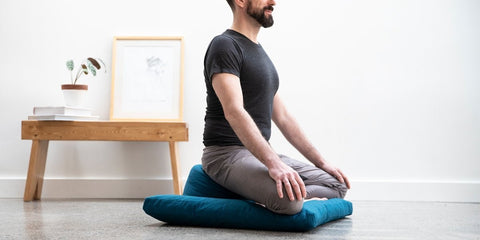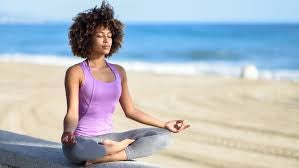Meditation 101 - How to get started
Posted on July 13 2020

- Find a relaxing environment
If you’ve never tried a sitting meditation before, start by creating a peaceful environment in which to meditate. When I prepare to meditate I try to ensure that I am comfortable and supported but also that I am in an area soothing to me. I love meditating on the beach!
Some people have rooms exclusively dedicated to meditation, but if you don’t have the space, no worries.
Again, this space will be unique to you and your tastes or needs. Walk around your space and see what feels right. If that doesn’t work, try the next space.
- Unplug
Turn off the TV, silence your phone, and play soothing music if you like. The point is to create an environment conducive to freeing your mind from its daily clutter and relaxing your body. Think waves hitting the shore. There are loads of apps available with music or sounds if you so choose. Experiment with those or just sit in silence. Sometimes the most profound learnings come during the “Pause” or silence.
- Choose your meditation position
If you can, sit on the floor and close your eyes. You don’t have to sit in the lotus position unless you want to, but sitting on the floor helps you feel grounded, connects you to Mother Earth, and roots you into your body when you meditate. Feel free to use pillows, cushions, and other props that help you feel comfortable.
Keep your back straight so you can breathe deeply with ease. If sitting on the floor is too uncomfortable, sit in a chair and place your feet firmly on the floor to develop a sense of grounding.

Tip: If you have tight hips or hamstrings, placing a bolster or pillow under your buttocks will raise you up and help alleviate some of the tension on knees and hips.
- Set a timer
Short term goals lead to more success! Be kind to yourself and take the worry out of the process by setting a timer. At first, I suggest only a few minutes (5 or so) then you can work up to a longer period of time.
Hint: The days I need meditation the most are usually those days that I find it hardest to really settle in. A timer helps with easing my mind. Ex. OK Sue you have 20 minutes. 20 tiny little minutes out of the entire day that are dedicated to your overall wellbeing. USE them. Everything else will come later.
- Close your eyes
Closing your eyes allows your mind to be aware inwardly. How do you feel in this space? What does your relaxed breathing feel and sound like? By closing our eyes we can reduce visual stimulants from interrupting our thoughts.
- Focus on your breath as you inhale and exhale
Meditation teacher Jack Kornfield suggests that if you notice yourself remembering, planning, or fantasizing, refrain from judging yourself, but do call it out. “Hello remembering.” “Hello planning.” “Hello fantasizing.” Then return to the present moment, focusing on your breath. I love this!
I practice visualizing myself in a snow globe, with my thoughts and ideas falling around me like little delicate snowflakes. I watch them fall then go back to my breathing and focus.
Another option that I teach quite frequently is to picture your thoughts floating out into the ocean. With each wave they get further away. Then return your attention to your breath.
I find focusing on the breath grounds one to the body and gives space to clear the mind.
- Be kind
If you can’t manage to relax, calm down or meditate for more than a few moments, don’t judge yourself. Remember this is YOUR time and you deserve to be congratulated for your practice. NOTE the word PRACTICE. That’s what this is. It is a practice. The more you try the better you will become at the process and the better you will feel.
I found this great step by step guide to meditation below. Read it through fully before trying to practice.
Hint: Record yourself reading # 1-#7. This will allow you to follow yourself into mediation.
- Lay down in a comfortable position with your head and neck supported, and take three deep cleansing breaths. Inhale through your nose and exhale through your mouth with your tongue pressed against the roof of your mouth.
- Imagine a ray/beam of light first entering your third-eye (located around the middle of the forehead, slightly above the junction of the eyebrows). Now imagine the light slowly moving downward scanning each part of your body.
- Take a few moments and just become aware of the flow of energy within your body, notice that it’s more than something happening within you, but it’s also apart of who you are.
- Now mindfully scan every cell in your body as you keep breathing slowly with intention. Every time you inhale, breathe in healing-nourishing energy. Every time you exhale, blow out any negative energy (stress, anxiety, fear, etc.) you may feel.
- Notice the flow of energy in your body again. There’s no right or wrong here, there’s only what is.
- If you feel negative energy or blockage in a certain area of your body, feel your way into it. Sit with it. Ask your body why* that block is there and what you need to do to release it.
- It helps to breathe into that area until you feel the block dissolving.
- When you feel the scan is complete, take three final deep cleansing breaths to clear out any energetic residue.

If you would like more information on guided mediation or self-relaxation tools, reach out. I am here to help.
Be well.
Sue
